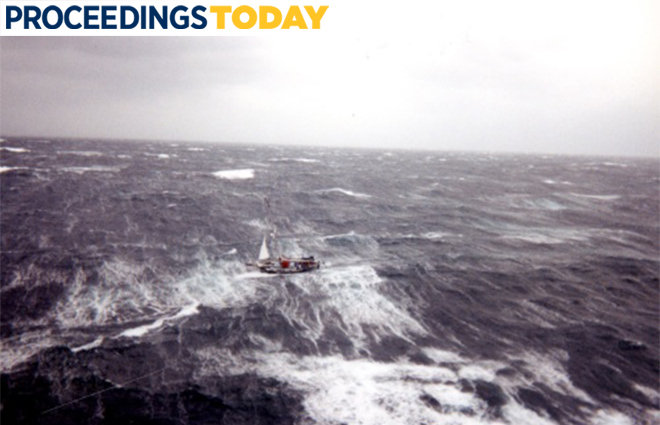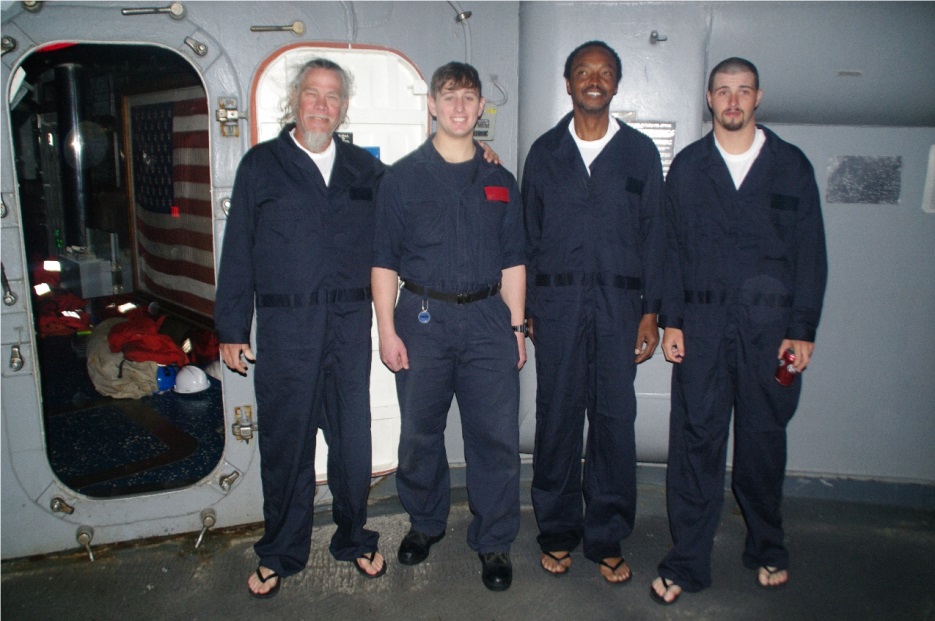
A real-world search-and-rescue at sea is different than a man-overboard drill, especially at night in bad weather.
The night of 27 March 2018 was starless and pitch black, with 10 foot seas and 20- to 30-knot winds. The USS Hue City (CG-66) was called to assist in recovering three distressed fishermen from the fishing vessel Barbara Lynne, some 40 miles off the northern coast of Florida. Despite doing hundreds of man overboard drills over the years, this was not a standard recovery, and there was little in our man overboard checklist that applied.
The Barbara Lynne had been at anchor when at 0300 something suddenly struck the boat, lifting it out of the water and throwing the three-man crew out of their racks and sucking them out into the Atlantic. The captain managed to transmit a single bridge-to-bridge transmission for help to the Coast Guard before he too was sucked into the water. The Barbara Lynne sank in less than three minutes.
Fortunately, the wreckage was very close to the reported position. Unfortunately, there was debris everywhere, with multiple lights in the water. Through night observation devices (NOD), at least four blinking lights were visible, but none of them close to each other. Lifejacket, life raft, and emergency position indicating radio beacon (EPIRB) lights are dim and difficult to see outside a mile or two. They are visible from much farther using NODs, but NODs do not allow for suitable depth perception. The Coast Guard had a helicopter in the area assisting in the aerial search and located one life raft. However, the possibility of multiple survivors in various locations led us to slowly approach each light, beginning with the identified life raft. Once alongside the life raft, a hand emerged from the darkness holding a flare, and we were able to yell to determine that all three crew members had made it into the raft with minimal injuries. Our SAR swimmer rescued the three fishermen using the J-Bar davit.

SAR swimmer Sonar Technician (Surface) 3rd Class Nathan Andrade (second from left) with the three fishermen he rescued.
The success of the Hue City’s operation was not because of luck. The crew performed well, each person seeing to his or her task and executing it with minimal direction. Later that day we performed a debrief to identify the key items that may help other ships in a similar situation:
- Announce to All Hands. The XO immediately announced the rescue on the 1MC to wake up the crew, let them know what was happening, and get a pool of spare personnel to the foc’sle to help our deck team. Deck Division were manning the foc’sle, boat deck, and, at one point, the flight deck. The extra personnel were crucial to our response.
- Tie the Raft to the Ship. Once in position, we tied the raft to the ship. This allowed us to keep contact with it despite high winds.
- Give the Conn to the CO. Some may say that the captain should stand back, direct, and keep the big picture. But after hundreds of man overboard drills, our CO was comfortable driving cruisers and destroyers. The XO and bridge team ran everything else flawlessly. The conditions made ship handling difficult, and this was not a teaching moment or a time to have a wrong order given. The Hue City was alongside the life raft for nearly an hour.
- Use your Ship’s Whistle. Search/signal lights commonly are generally used to get the attention of survivors and let them know help is there. In our case, all three survivors had zipped themselves up inside a life raft together in an attempt to maintain precious heat. They never would have known we were there if they had not heard us.
- Consider a foc’sle recovery. Seas were rough and when we approached the life raft our leeward boat davit was broken. With so much debris in the water, we were not comfortable with extra maneuvering. Also, the Coast Guard helo was low on fuel and unable to do a recovery.
- Delegate the helo. The helicopter was reassigned to investigate the other lights while Hue City made an approach on the life raft. In other conditions, a helo (or small boat if sea conditions support) is the best asset to search through a debris field when looking for survivors.
- Communicate Positions. Because of the bridge location and curve of the bow on a cruiser, it was impossible to see the life raft once it was below the J-bar davit and the wind pushed the ship against it. One quick thinking officer went to the foc’sle with a radio and provided position updates to the bridge so we could maintain position.
- Make Vision a Priority. We had a difficult time seeing what was in front of us while navigating the debris field. The visit, board, search, and seizure (VBSS) officer went to the gear locker and broke out the antiterrorism (AT) lights, VBSS lights, and even water line security lights. Of note, be careful not to point lights toward the helo since they are on NVGs.
- Have cryptologic technicians look for the EPIRB signal on their equipment.
- Think About Flares. The flares used by the fishermen were handheld and did not shoot up in the sky. They confused us because they looked like a different colored light instead of a flare.
It is our hope that the lessons gleaned from the quick actions of Hue City’s crew will help if your ship is ever called on to conduct a search-and-rescue mission.
For more Proceedings content, click here.


